
Japanese Banknotes
The Hansatsu scripts were issued during the Edo period by the feudal domains.
The scripts below were probably issued between 1854 and 1860.
 |
 |
| Hansatsu script |
| Sendai domain |
| 金壹 1 unit of gold |
| 5x15.5cm |
|
 |
 |
| Hansatsu script |
| Sendai domain |
| 弐朱 2 Shu |
| 5x15.5cm |
|
The Dajokan-Satsu were the first national currency of the Meiji era, issued by the Dajokan in July, 1868.
1 Ryo = 4 Bu
1 Bu = 4 Shu
The hole at the top of the banknote seems to be a standard feature of these bills.
The references S164, etc, are from the book Standard Catalog of World Paper Money, Specialized Issues, by
George S. Cuhaj, 11th edition, 2009, p.727 ff.
 |
 |
| Dajokan-Satsu gold note |
| 慶應 辰 Keio dragon = 1868 |
| 金壹兩 gold 1 Ryo |
| S164 |
| 4.2x13.2cm |
|
 |
 |
| Dajokan-Satsu gold note |
| Meiji snake = 1869 |
| 金壹分 gold 1 Bu |
| S163 |
| 3.9x10.2cm |
|
 |
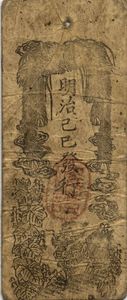 |
| Dajokan-Satsu gold note |
| Meiji snake = 1869 |
| 金壹朱 gold 1 Shu |
| S162 |
| 3.8x9.0cm |
|
This is a 10 sen note issued by the Hokkaido Development Board and refundable at Mitsui Bank. Hokkaido is Japan's large northern Island which Japan claimed in 1868, appropriating it from the indigenous Ainu people, and began developing soon after. This bill was issued in 1872 to help fund the project of sending settlers to develop the Island. (Information kindly provided by Luke Roberts).
 |
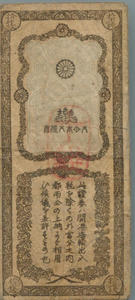 |
| Hokkaido Development Board |
| 1872 |
| 10 Sen |
| P1 |
| 3.4x7.7cm |
|
 |
 |
| Japanese Imperial Governement currency |
| 1872 |
| 10 Sen |
| P1 |
| 5.4x8.9cm |
|
 |
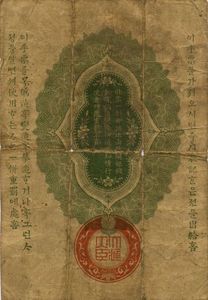 |
大日本帝國 政府 Japanese Imperial Government
軍用手票 Bill for military use |
| Meiji 37 = 1904 |
| 20 Sen (貮拾錢) -- no serial n# on back |
| P-M2b |
| 7.0x10.2cm |
|
 |
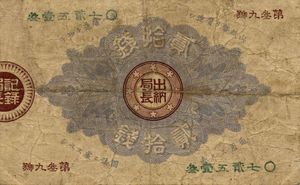 |
| Japanese Imperial Government Currency |
| Meiji 40 = 1907 |
| 20 Sen (貳拾錢) |
| P15 |
| 9.2x5.7cm |
|
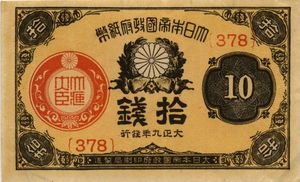 |
 |
| Japanese Imperial Government Currency |
| Taisho 10 = 1922 |
| 10 Sen (貳錢) Block-378 |
| P46c |
| 3.9x10.2cm |
|
1 Yen = 100 Sen



